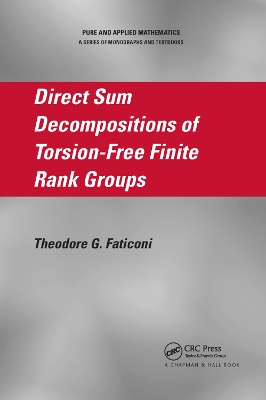Pure and Applied Mathematics
2 total works
Classic arguments and illustrative examples are provided throughout the book and are accompanied by a gradual progression of sophisticated notions designed to stun your intuitive view of the world. With a thoughtful and balanced treatment of both concepts and theory, "The Mathematics of Infinity" focuses on the following topics: Sets and Functions; Images and Preimages of Functions; Hilbert's Infinite Hotel Cardinals and Ordinals; the Arithmetic of Cardinals and Ordinals; the Continuum Hypothesis Elementary; Number Theory; the Riemann Hypothesis; and, the Logic of Paradoxes. Recommended as recreational reading for the mathematically inquisitive or as supplemental reading for curious college students, the "Mathematics of Infinity: A Guide to Great Ideas" gently leads readers into the world of counterintuitive mathematics.
Direct Sum Decompositions of Torsion-Free Finite Rank Groups
by Theodore G. Faticoni
With plenty of new material not found in other books, Direct Sum Decompositions of Torsion-Free Finite Rank Groups explores advanced topics in direct sum decompositions of abelian groups and their consequences. The book illustrates a new way of studying these groups while still honoring the rich history of unique direct sum decompositions of groups.
Offering a unified approach to theoretic concepts, this reference covers isomorphism, endomorphism, refinement, the Baer splitting property, Gabriel filters, and endomorphism modules. It shows how to effectively study a group G by considering finitely generated projective right End(G)-modules, the left End(G)-module G, and the ring E(G) = End(G)/N(End(G)). For instance, one of the naturally occurring properties considered is when E(G) is a commutative ring. Modern algebraic number theory provides results concerning the isomorphism of locally isomorphic rtffr groups, finitely faithful S-groups that are J-groups, and each rtffr L-group that is a J-group. The book concludes with useful appendices that contain background material and numerous examples.

